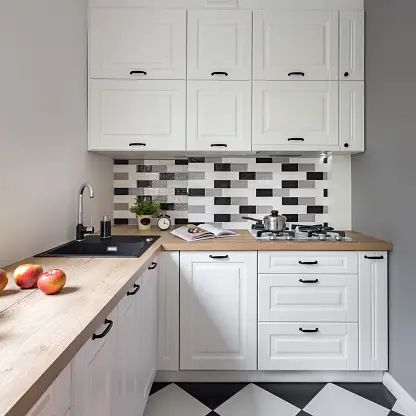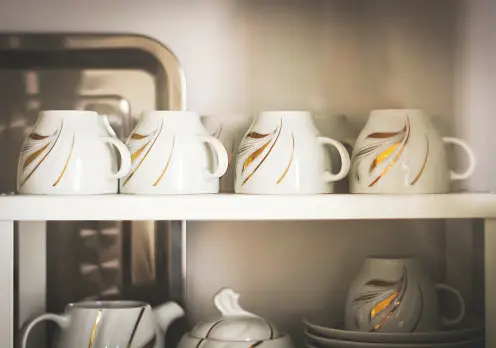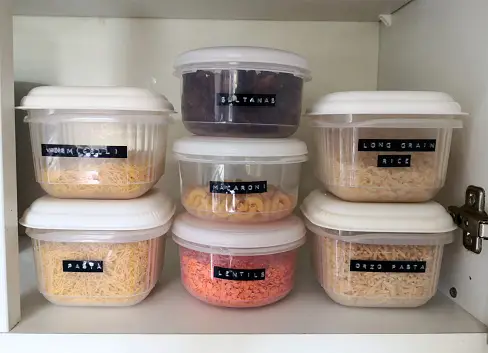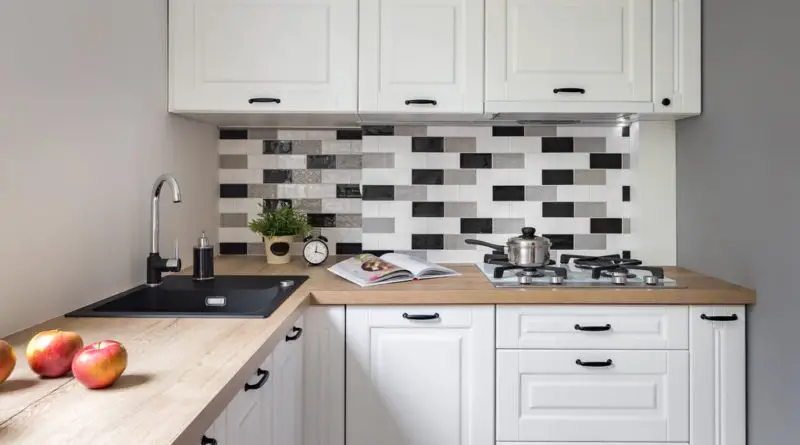Tips for Organizing a Small Kitchen

Organizing a small kitchen can be a challenge.
Do you feel like you’re constantly running out of space in your kitchen?
Or perhaps it’s just hard to find what you need when you need it. If so, you’re not alone. A lot of people struggle with kitchen organization.
Use these tips to get your small kitchen organized once and for all!
Clear out the unnecessary
The first step in creating order in your small kitchen is to get rid of everything you don’t need.
The more items you can eliminate, the easier it will be to organize what’s left into an efficient working space that still looks good.
Look through your pantry, refrigerator, freezer, and cabinets with a critical eye. And evaluate what you use daily.
Here are a couple of questions to keep in mind:
– Do you use this item regularly?
– Is this item expired or near expiration?
At the end of the day, the goal is to store things efficiently. And to store similar items together, organize items in a way that makes sense, to save space and time.
Storage space saving tips
Once you’ve removed everything from your cabinets, you can experiment with new storage solutions for your kitchen.
Lazy Susan
If you have corner cabinets or shelves where items get lost at the back, a lazy Susan is a great addition for small kitchens. They’re a big help in pantries to organize canned goods and other items that tend to get lost or buried at the back.
Lazy Susans organize small kitchens well by maximizing space and allowing quick access to items. The rotating design makes it easy to find everything quickly without having to dig through cupboards.
Expandable drawer organizers
A great way to organize a small kitchen is to make better use of drawer space by using expandable organizer trays that fit inside the drawer. Many are adjustable so you can change their size for bigger or smaller items, depending on your needs.
Shelf dividers

If your kitchen cabinets have adjustable shelves, it’s worthwhile to invest in some shelf dividers. The adjustable nature of these dividers means you can organize your items in a way that makes sense.
Vertical space
Everything takes up more room when it’s spread out. When organizing a small kitchen, place items vertically so they take up less room horizontally.
Look for wall space, to organize spices and other items that can be placed in racks or on hooks instead of taking up counter or cabinet space.
One option for pots and pans is to store them on a vertical storage rack, AKA hanging rack, again making the most of your wall space.
Pantry storage ideas
If your small kitchen has a pantry, organize it wisely and efficiently by using the back of your pantry door. Install an over-the-door shoe rack or a tension rod to organize spices, oils, and vinegar so you can quickly find the item you’re looking for when you need it.
Storing items in baskets is also a great way to maximize pantry space because it keeps items visible and easily accessible.
You’ll want to organize food items in your pantry and refrigerator with clear containers. This will make it easier to identify what you have on hand immediately and to select ingredients for meal plans or recipes.
Also, consider organizing spices in alphabetical order or by frequency of use so that they are easy to find on busy mornings when you’re trying to get out the door and make breakfast.
Pantry shelves
Organizing the shelves in your small pantry is a good tip. Place items that you use often in the front of the shelves and items that you don’t use as often behind them.
As mentioned, a lazy Susan comes in handy in the pantry. Place it in the corner to organize staples and smaller items. You can also organize spices with a metal rack or by putting them in small tin buckets.
As well, grouping like items together will help you identify your inventory and when you’re running low on something. Group all the spices in one area, as well as all commonly used non-perishable groceries.
What if you don’t have a pantry?
If you don’t have a pantry, use your cabinets, instead.
Utilize racks and containers to organize spices, cooking oils, and other items.
Once again, the best thing to do is to organize the items that you use most often at eye level and organize items that you don’t use as often on the bottom of the cabinets.
Using labels will give you a quick bird’s eye view of your supplies.

Containers take up less room and enable you to organize pantry items in a more space-efficient manner.
For instance, containers labeled “snacks” make it easy for everyone in the family to grab a treat rather than hunting high and low.
When using your cabinets as a pantry, you want to containerize items as best as possible. And organize them according to usage patterns instead of trying to cram everything into the cabinets.
Sink and countertops
As already mentioned, you can create more room in a small kitchen by re-organizing the way things are stored and making use of organizational tools.
Now, organization tools don’t have to cost much or be overly complicated. They can be simple products that organize small kitchens well by making it easier to organize items according to frequency of use.
A few inexpensive options for organizing a small kitchen include:
– IKEA’s dish drainers, can be folded up and put away when not in use.
– A wall-mounted drying rack. It doesn’t take up much space and can be pushed out of the way when necessary.
In terms of counter space, it’s likely to be limited. So, restrict yourself to one countertop appliance. And tuck the others away on lower cabinet shelves to keep your countertop clutter-free.
Keep your most used items within easy reach. Everything should be at arm’s length. For instance, things like trash cans or recycling bins are to be close to the sink so that they are easily accessible when you need them.
Dedicating one area for food preparation and keeping cooking utensils close by in a small kitchen at home is possible when you have the right storage system. All you need to do is keep the utensils and appliances you use most often within easy reach, tucked away out of sight in a storage carousel, such as a lower cabinet or shelf.
Recap
Now that you have the tips for organizing a small kitchen, it’s time to get organized! Clear out any unnecessary items and appliances so you can start with a clean slate. Next, use strategic placement of cabinets and shelves to make the most of your space. Finally, add organizational tools like lazy Susans, drawer dividers and cabinet organizers to make accessing your supplies quick and easy. With these tips, your small kitchen will be totally organized in no time!
